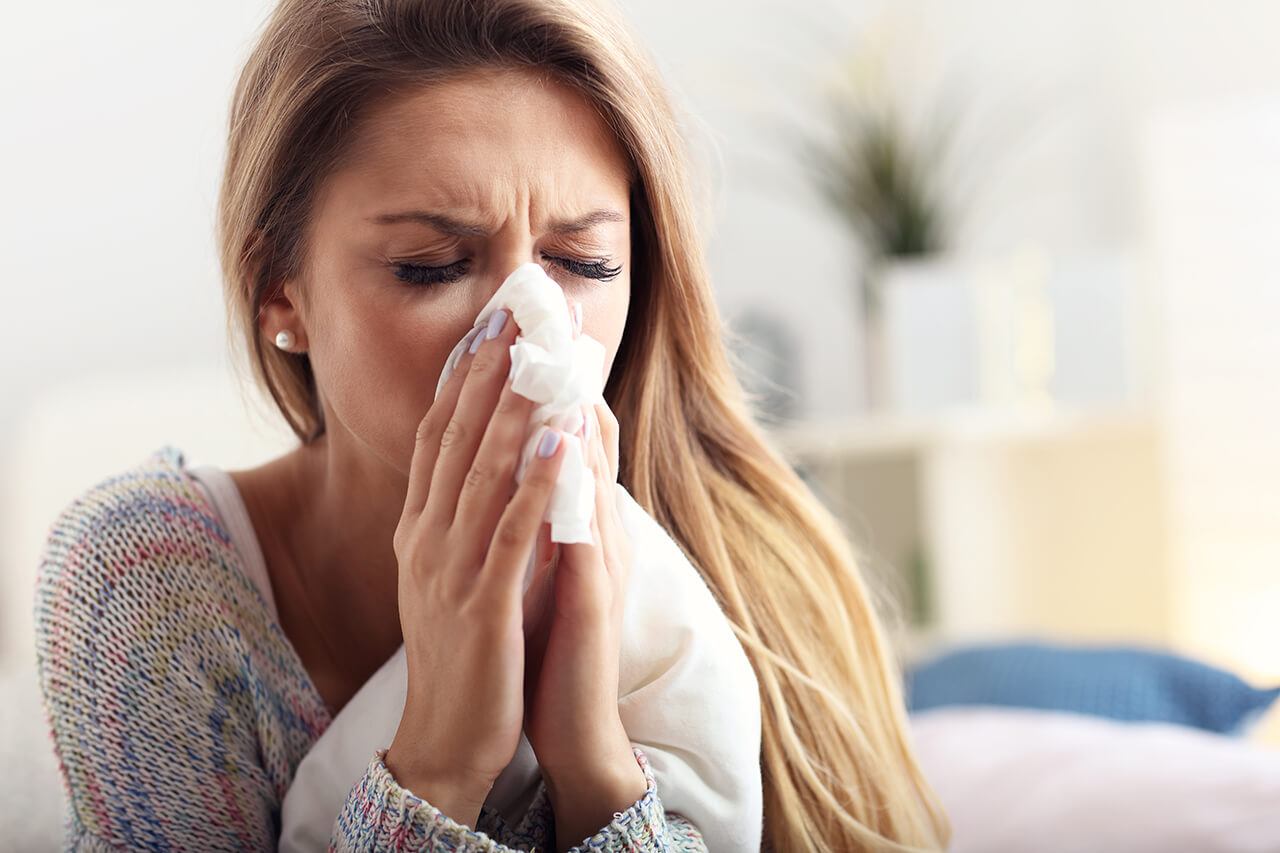Overview
If you have congestion and a runny nose, or you’re sneezing and coughing, your first thought may be that you have a cold. Yet, these are also signs of allergies.
By learning the differences between allergies and colds, you can find the right method of relief — fast.
What is a cold?
A cold, also known as “the common cold,” is caused by a virus. Many different types of viruses are responsible for colds. While the symptoms and severity may vary, colds generally share some of the same basic characteristics.
Here are some key features of the common cold:
- Colds are transmitted through virus droplets that a sick person sheds when they cough or sneeze.
- In addition to coughing and sneezing, cold symptoms can include a sore throat and a runny, stuffy nose.
- More severe colds can also cause headaches, fevers, and body aches.
- Recovery from a cold is usually quick. The average duration of a cold is 7 to 10 days.
- If symptoms last more than a week or two, the virus may have contributed to a more serious infection, such as a sinus infection, pneumonia, or bronchitis.
- People with allergies may be more prone to catching colds.
Despite its name, you can catch a “cold” at any time of the year, even in summer. The Centers for Disease Control and Prevention (CDC) estimate that the average healthy adult catches two or three colds per year.
Young children may get even more colds because of their less mature immune systems.
What are allergies?
Allergies occur when your immune system has an adverse reaction to certain substances. When you’re exposed to an allergy trigger, known as an allergen, your immune system releases chemicals called histamines. This release of histamines is what causes allergy symptoms.
Allergies and colds share some common symptoms, such as:
- sneezing
- coughing
- sore throat
- runny nose
- nasal congestion
- watery eyes
Allergies can also cause rashes and itchy eyes. The common cold typically does not.
Every year, over 50 million Americans experience allergies. Seasonal allergens such as tree, grass, and weed pollen are common triggers, but you might be allergic to certain substances year-round.
Other allergy triggers can include:
- dust mites
- animal dander or saliva, such as from a cat or dog
- mold
- foods, such as peanuts, tree nuts, milk, and eggs
Colds vs. allergies: How to tell the difference
Since colds and allergies have many of the same symptoms, it may be hard to tell the two conditions apart.
One way to tell what’s making you feel unwell is to pay attention to the symptoms that they don’t share.
Colds are more likely to cause:
- fatigue
- aches and pains
- sore throat
- fever
Allergies are more likely to cause:
- itchy eyes
- wheezing
- skin rashes, such as eczema or hives
The ‘allergic salute’ | Allergies in children
Another telltale sign of allergies — especially in children — is called the “allergic salute.” Kids with allergies have an itchy nose, which they often rub with an upward hand motion that looks like a salute.
Time of year | Time of year
The time of year can provide clues to the cause of your symptoms. You’re more likely to catch a cold during the fall and winter months, although it’s possible to come down with one in the spring and summer, too.
Allergies can also strike at any time of year, but pollen allergies are most common during the spring months. Grass allergies are highest in late spring through summer, while ragweed allergies occur during late summer and fall.
Duration of symptoms | Duration
Another way to tell whether you have allergies or a cold is by the duration of your symptoms. Colds get better within a week or so. Allergies won’t go away unless you get treated or remove the trigger. Seasonal allergens tend to cause symptoms two or three weeks at a time.
A common misconception
If you’re looking at the color of your snot, or mucus, to tell whether you have a cold or allergies, you won’t find much help there.
Despite the common misconception that green nasal discharge is a sign of an infection, allergies can cause discharge from your nose in all different colors. And a cold often can make your nose run clear.
Diagnosing colds and allergies
You don’t need to see your doctor for a cold, but if you do make an appointment, your symptoms will likely be enough for them to confirm your diagnosis.
If your doctor thinks you might have a bacterial infection such as strep throat or pneumonia, you might need other tests such as a throat culture or chest X-ray.
For allergies, you may need to see a primary care doctor, an ear-nose-throat (ENT) doctor, or an allergist. The doctor will first ask about your symptoms. Severe or life-threatening allergic reactions often require the care of an allergy specialist.
A variety of tests can be used to diagnose allergies. A skin test can be used to determine your allergy triggers. Sometimes primary doctors or allergy specialists may also use blood tests to diagnose allergies depending on your age and other health conditions.
Treating the common cold
Your body will get rid of the cold virus over time. Since antibiotics only kill bacteria, they won’t work on the viruses that cause colds. Still, there are medications that can help relieve your symptoms while a cold runs its course.
Cold remedies include:
- cough syrups and over-the-counter (OTC) cold medications
- decongestant nasal sprays
- pain relievers, such as ibuprofen (Advil) or acetaminophen (Tylenol)
Cough syrups and OTC medications aren’t recommended for children under 4 years old, while nasal sprays aren’t recommended for children under age 6.
Ask your doctor before taking any OTC cold medication, especially if you also take prescription medications, have any existing health conditions, or are pregnant.
Don’t use cold medications for a long period of time. Using them for extended periods can cause side effects such as rebound congestion.
You can also try home treatments to relieve a cold, such as:
- drinking more fluids like water, juice, and herbal tea
- avoiding caffeine
- using saline nasal sprays
- using nasal rinses, like a neti pot
- gargling with salt water
- getting a cool-mist humidifier
Treating allergies
One very effective way to prevent allergy symptoms is to avoid your triggers. If you can’t avoid your triggers, you can take medications to relieve your symptoms.
Antihistamines
Antihistamines work by blocking the release of histamine. Examples include:
- fexofenadine (Allegra)
- diphenhydramine (Benadryl)
- cetirizine (Zyrtec)
Be aware that some older antihistamines can cause drowsiness. Either look for a nondrowsy formula or consider taking these medicines at night.
Decongestants
Decongestants work by shrinking swollen nasal membranes to relieve sinus congestion. They’re sold under names such as:
- pseudoephedrine (Sudafed)
- guaifenesin-pseudoephedrine (Mucinex DM)
- loratadine-pseudoephedrine (Claritin-D)
Decongestants come in pills and nasal sprays. However, nasal decongestants such as oxymetazoline (Afrin) can make your congestion worse if you use them for more than three days in a row.
Nasal corticosteroids
Nasal corticosteroids bring down swelling in the nose by blocking inflammation. They also lower the number of allergy-activated immune cells in the nasal passages.
These medications continue to be one of the best ways of controlling and treating both seasonal and year-round allergies.
Eye drops
Eye drops can relieve itchiness and watering.
Allergy shots
Allergy shots gradually expose you to small amounts of the allergen. This exposure helps to desensitize your body to the substance. These can be a very effective long-term solution for eliminating allergies.
Other treatments
As with cold symptoms, saline sprays and humidifiers can help relieve certain allergy symptoms.
Outlook for allergies and colds
While some allergy and cold symptoms are similar, these are two very different health conditions. Knowing which one you have can help you get the right treatment, so you’ll be on your way to feeling better quickly.
If your symptoms don’t improve with treatment, or if you have a rash or you’re running a fever, see your doctor to rule out a serious medical condition.
Both colds and allergies can cause viruses and bacteria to collect in the sinuses and lower airways, which can lead to more serious infections.
If your symptoms are lasting more than 10 days or you’re getting worse, see your doctor.





